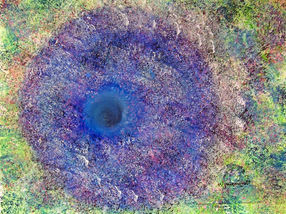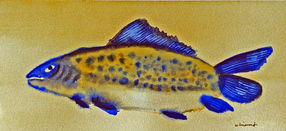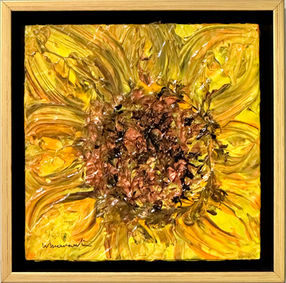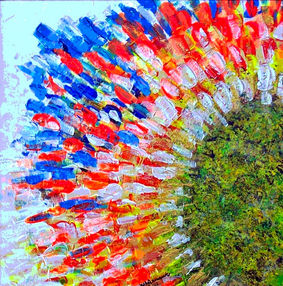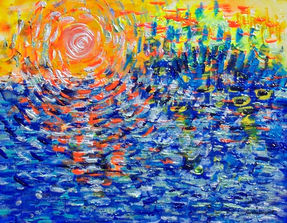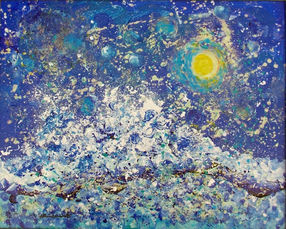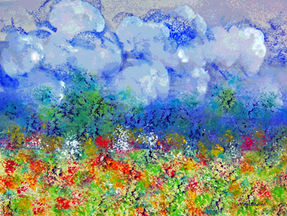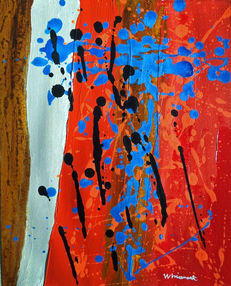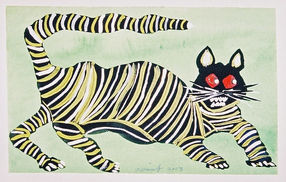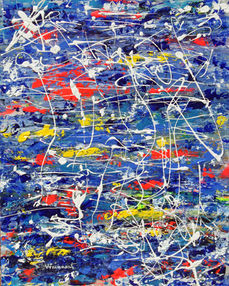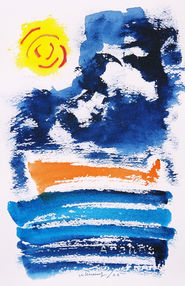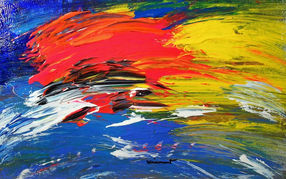shootingatrandom.com

PAINTED PICTURES
"Half of my life so downhearted, I'm already an old man; standing alone in my study, the evening wind moans.
Bright pearls from beneath my brush can't be sold anywhere; so I fling them here, cast them there, amidst the
wild vines." - Xu Wei
"Painting is an old man's game," said Claude Monet, so when I retired at 55, not quite a codger, but on the brink, I took a cue from the great impressionist and started to paint. I was also inspired by Henri Cartier-Bresson, who turned to drawing and painting at age 75 after a stellar career as a photojournalist. Why painting? I love the flexibility and spontaneity of the medium, it's as simple as that. When struck by an idea, all I need is a sheet of paper or canvas panel, some paints and brushes and I'm ready to go to work. Painting is a swift and instantaneous pictorial vehicle, an immediate means of recording the inner visions that delight and inspire me. There's a simplicity and fluidity about painting that facilitates freedom of expression, a vitality and liveliness akin to a scherzo in a music composition. I am also fascinated with the mysterious processes of craft and design, an inclination that often triggers a desire to share ideas with others. As Gertrude Stein once said, "It is natural that I should tell about pictures, that is, about paintings. Everybody must like something and I like seeing painted pictures."
Another inspiration to try my hand at painting came in the form of a little book called To Paint Is To Love Again, Henry Miller's joyous account of his life-long fascination with the art of the watercolor. I acquired Miller's classic serendipitously, the way all truly transformative events in life seem to happen. I was helping an artist pal named Eduardo Benzine organize his books during a move and found this little gem of Miller's in a stack of old paperbacks. Since Benzine had to vacate the premises fast and travel light, he was eager to trade books for cash and I got To Paint Is To Love Again for dollar. It was a bargain for sure, but unlike the person who knows the price of everything and the value of nothing, I realized I had purchased a treasure impossible to evaluate in mere monetary terms. (Collectors of Miller's book in good condition now sell for hundreds of dollars.)
Rereading To Paint Is To Love Again recently, I was struck by how fresh and inspiring the book has remained over the years, attributed no doubt to its rich vein of painting lore and artistic insights that makes it impossible to comprehend its full meaning in one sitting. Perhaps that's also why I turn again and again to Miller's writings on the subject for inspiration and motivation. Neophyte painter though he claimed to be, Miller was nevertheless a great guide for those who seek to understand the "inner" reality of the artist, a territory Miller explored with passion throughout his entire life as a writer. "The reality is always thee," wrote Miller, "and it is preceded by vision. And if one keeps looking steadily the vision crystallizes into fact or deed. There is no escaping it. It doesn't matter what route one travels--every route brings you eventually to the goal. All roads lead to heaven is the Chinese proverb. If one accepted that fully, one would get there so much more quickly."
For Miller, the artist's primary task is to use his work to lift up the spirit of man, to bring it into harmony with cosmic realities and "thereby recover the poetic vision of things which has gone out of the world," as he once explained in an interview. His eloquent writings on the spiritual dimension of creativity serve as a continual reminder that, "the intelligence which directs the Universe, or the Mind which is the Universe, is there to draw on, there to collaborate with, when you stop trying to run the show." This inspired approach to painting seems especially amazing when one considers that Miller produced many of his best pictures when he was in in his 60s, rich, vibrant watercolors with cosmic themes, masterful compositions and Dionysian movements. The originality and profound simplicity of his work reflects " a transcendental spirit whose vision illumines the cosmic heritage of mankind," as painter Beaufort Delaney once described his mentor.
All that Miller achieved as a writer, all that he loved and celebrated in his books is also expressed in his incomparable watercolors, works of art which, over and above everything he created, will ensure his immortality. Out of his expansive, Rabelaisian sensibility he projected a compassionate acceptance of life and a fearless curiosity about everything under the sun that makes his paintings, as well as his books, so immensely appealing. His pictures, like his writing, convey "the feeling of abundance and vivacity that characterized his mind and heart," as novelist Lawrence Durrell wrote of the effect of Miller's watercolors.
In her wonderful book about Miller, The Devil at Large, Erica Jong cites the liberating effect of Miller's language that sets him apart from other writers. "For the most part, the 'ficitional' novels we read today belong to a dead genre, a genre that somnolizes rather than awakens," explains Jong. "People read mysteries, romances, and thrillers to anesthetize themselves, not to alert their souls. Most books are enslaving rather than liberating. They lull the senses; they hypnotize the moral imagination. But Miller is doing something else entirely--and it is necessary to recognize it. He is using words in the service of liberation." Art is not only a means to life, to the life more abundant, he wrote in Big Sur and The Oranges of Hieronymus Bosch. "It merely points the way...in becoming an end, it defeats itself...Whoever uses the spirit that is in him creatively is an artist. To make living itself an art, that is the goal."
- Stewart Whisenant

Select a brush to start the show...
Excerpt from my Guest Book
"Charming Darling! Too, too Divine. When Beresford
returns from his bone fishing trip with Jimmy Cadwalder
and Rokie Melon, I'm going to insist that we have all of
our friends over for an art party and we can all invest in
your charming blue-chip art. This will appeal to Beresford;
he is so stodgy about normal artists,(dirty Bohemians)...but
he will adore your blue-chip paintings. You see, he looks
after our money, and he only keeps blue-chip stocks in the
portfolio, so of course, you see what fun this will be !!! I do
hope your prices aren't too high!!! My husband feels that
art should never have more than two digits before the
comma--is that possible? Oh, Mr. Whisenant, may I call
you Stewart? We do look forward to our little splurge,
and if I serve a few of my special cocktails, I'm sure that
our little art party will be a smashing success! Of course,
Stewart, I feel as though we have known each other for a
hundred years, so perhaps it wouldn't be to forward of me
to ask if you ever paint nudes. I can tell from your art that
you are a man who knows how to handle a woman, and I
do play tennis at the club every day, and although I am no
longer a teen-ager, I do turn a few middle-aged heads. So
if you do accept figure models...Well, back to business, I think
you are the most brilliant artist, and please call me."
- Tinki Tinki Tipton Au Naturale


